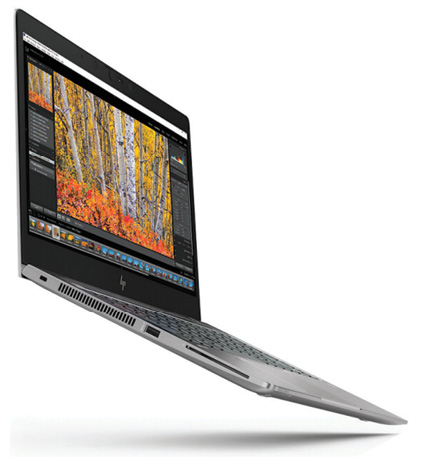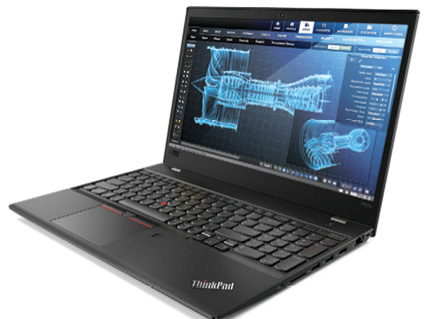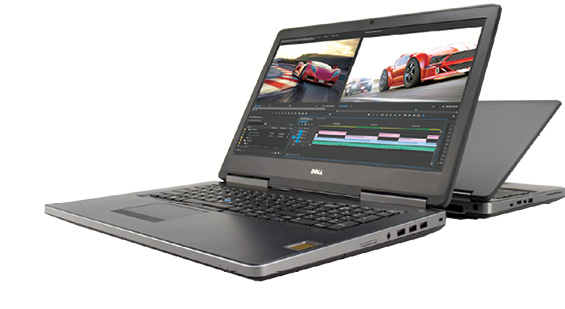Mobile Workstations Provide Portable Engineering Power

The Lenovo ThinkPad P52 is the first Lenovo thin-and-light mobile workstation to run a quad-core Intel CPU. Image courtesy of Lenovo.
March 1, 2018
When buying computers, the price/performance curve is an ocean wave and the marketplace is divided into beachcombers, swimmers and surfers. Beachcombers are consumers; swimmers are enterprise users. They have low expectations of the ocean and won’t pay much extra for a “premium” wave experience. Engineers are surfers. They want the big wave of power.
As a result, workstation-class computers continue to gain in sales, while consumer and enterprise PC markets continue to shrink. Market watchers like Alex Herrera at Jon Peddie Research (JPR) report that workstation sales continue to grow at a faster rate than the rest of the market, and in 2017 mobile workstation sales grew even faster than desktops. In the third quarter of 2017 alone workstation sales revenue was $2.36 billion, according to JPR, on sales of 1.25 million workstations (desktop and mobile).
 The new HP ZBook 14u G5 mobile workstation offers AMD Radeon Pro graphics. Image courtesy of HP.
The new HP ZBook 14u G5 mobile workstation offers AMD Radeon Pro graphics. Image courtesy of HP.“Professionals are more mobile than ever,” notes Scott Hamilton, a Dell workstation market specialist. “They need powerful systems they can take on the go. Engineers specifically are spending more time in the field, whether working from a home office or at different job sites.”
The desire for increased mobility by itself would not drive increased demand for mobile workstations if performance was compromised. “Performance limited the growth in mobile workstation sales in years past,” says Sean Young, HP’s workstation global lead for product development and AEC. “There was an inflection point last year, where workstation users started replacing desktop units with mobile workstations.”
Customers want both portability and power, but what has changed is the performance specs of mobile units. “Thin and light are constants” for most mobile users, Young says; only a thin segment of the market will consider a heavy mobile workstation that offers no performance compromises. “But the definition of ‘power’ varies with the customer and the workflow.”
 The Lenovo ThinkPad P52 is the first Lenovo thin-and-light mobile workstation to run a quad-core Intel CPU. Image courtesy of Lenovo.
The Lenovo ThinkPad P52 is the first Lenovo thin-and-light mobile workstation to run a quad-core Intel CPU. Image courtesy of Lenovo.Another factor driving increased use of mobile workstations is the greater willingness to work collaboratively. Chris Russo, Lenovo’s industry expert for AEC and product development, says mechanical engineering is one of several engineering disciplines where he sees an increase in collaborative work. One large Lenovo customer recently moved its entire design and engineering staff from desktop to mobile workstations. “They saw it was easier to work with vendors or from remote job sites,” he says.
Breaking Moore’s Law
There is talk in the computer industry that using Moore’s law to describe computer performance growth is an outdated notion. Raw growth in number of transistors is not a valid measurement, the thinking goes. Instead, the argument goes, look to other improvements such as the Intel Xeon class of CPUs, which are designed as server CPUs but are now finding their way into workstations with their support for error-correcting code memory, higher core counts and support for greater amounts of RAM.
The response from graphics processing unit (GPU) vendors could be characterized as “hold my beer.” Both NVIDIA and AMD are packing more transistors and more performance power into smaller footprints with every product update. HP’s Young notes the current high-end NVIDIA mobile GPU, the P5000, is powerful enough to run such demanding applications as CATIA or NX.
 The Dell Precision 7720 mobile workstation offers a 17-in. viewing screen and seemingly unlimited configuration options. Image courtesy of Dell.
The Dell Precision 7720 mobile workstation offers a 17-in. viewing screen and seemingly unlimited configuration options. Image courtesy of Dell.Professional rendering software is now embedded into most MCAD products, notes NVIDIA’s Andrew Rink. “Designers have been exposed to easy rendering; its use is accelerating,” he says. The P5000 will be available from various mobile workstation vendors as they refresh their product lines in the first half of 2018; models from Dell and HP are already available.
AMD has increased its R&D in the mobile workstation space in the last two years, yet holds a very small market share. HP and Dell offer AMD products as options in some of their mobile workstations for customers who have standardized on specific GPU technology and who have mainstream uses (AutoCAD, SOLIDWORKS) for mobile workstations. AMD counters the NVIDIA advantage of its CUDA graphics programming language by embracing open standards.
Real-Time Simulation Pushes the Envelope
Engineering graphics are moving beyond the flat screen with an explosion of new use cases. Virtual reality and augmented reality have become a necessary extension of product development. Robotics engineering is using VR as a prototyping environment, to test fully functional—albeit virtual—robots before they are built. Internet of things applications, parts created with 3D printing and autonomous vehicles all benefit from real-time visualization as part of the engineering process.
These new domains are computationally intensive. Consider design review of an automobile in virtual reality. The workstation must deliver 90 frames per second (fps) of high-quality graphics in real-time response to the observation and movement of the VR user; the field of view can change unpredictably at any time. That is four times as much graphics throughput than required to put a 3D CAD model on a flat display. The amount of data required exceeds the memory and bandwidth specs on most computers.
Not every GPU board on the market is powerful enough to run such new engineering use cases. The latest versions of both the AMD Radeon Pro and the NVIDIA Quadro P5000 can support this level of graphics intensity.
“There is an expectation of visual data use,” says HP’s Young, for product visualization and for upfront simulation. “Looking at airflow, a static image doesn’t cut it; you need an animation.”
Every vendor interviewed for this article pointed to the new ANSYS Discovery Live as a “killer app” for next-generation engineering graphics. It is designed to work with the CUDA graphics programming environment, so it requires NVIDIA GPUs. Rink says it “works fine” on a single Quadro P5000 mobile GPU and is easy to use. Rink sees early stage product development collaboration as an ideal use for Discovery Live on a mobile workstation. “An engineer can make little adjustments to a product sitting with the customer, quickly testing and making incremental changes.”
Other Workstation Trends
We all use a finger or a stylus to navigate our smartphones and tablets. But within product development, that sort of input has been limited to early-stage industrial design. But things are changing. SOLIDWORKS 2018 supports pen-based workflow, for example; so do various apps in the CATIA ensemble. Siemens Solid Edge and NX units work closely with Microsoft on its Surface technology. In 2018 all the leading mobile workstation vendors will offer more options for pen and touch user interaction, starting with various thin-and-light ultrabook models where touch interaction is a market expectation.
Other market trends that will affect mobile workstations in 2018 include the following:
More RAM: “CAD models aren’t getting smaller,” notes Lenovo’s Russo. 64GB of RAM has been standard for the higher-end mobile workstations but is now moving into the mainstream and ultrabook segments of the market.
Storage without moving parts: The transition away from optical drives is nearly complete—and mechanical hard drives are not far behind. The new technology standard for solid-state drives (SSD) is non-volatile memory express (NVMe). Like SCSI and SATA for mechanical drives, NVMe takes better advantage of the data pipeline. NVMe improves on previous data storage specifications by only requiring a single message for a 4KB data transfer (instead of two messages). Older standards processed one data queue at a time; NVMe can process 65,536 at a time. The bigger the engineering model, the more back and forth takes place between RAM and storage. Engineers who upgrade to a mobile workstation using NVMe will notice a substantial performance improvement.
Thunderbolt connectivity: Shop carefully if you have a preference for device connections beyond Thunderbolt. Older standards including HDMI or USB are on the wane in mobile workstations as Thunderbolt becomes an industry standard.
More Info
Subscribe to our FREE magazine, FREE email newsletters or both!
About the Author
Randall S. Newton is principal analyst at Consilia Vektor, covering engineering technology. He has been part of the computer graphics industry in a variety of roles since 1985.
Follow DE





